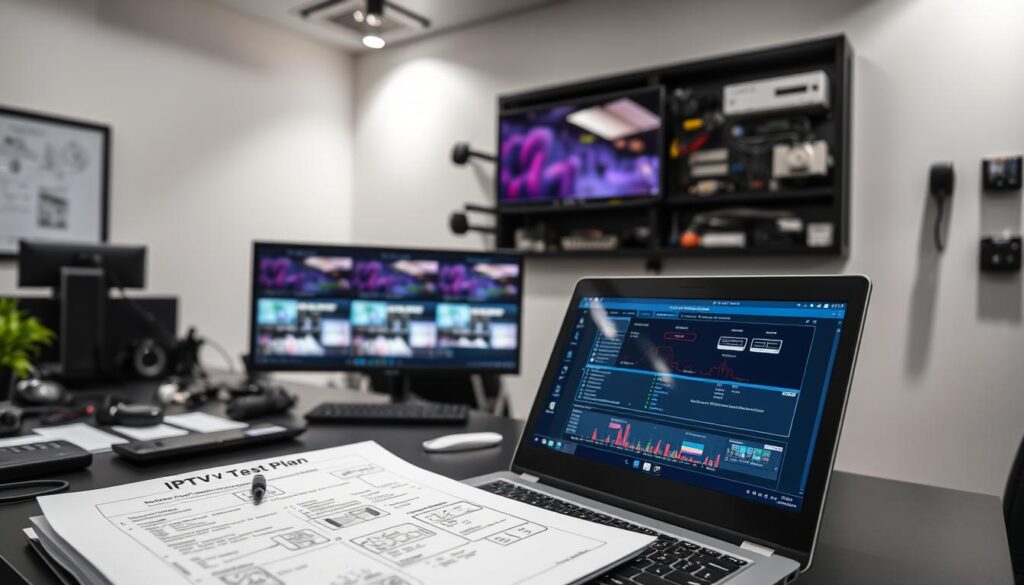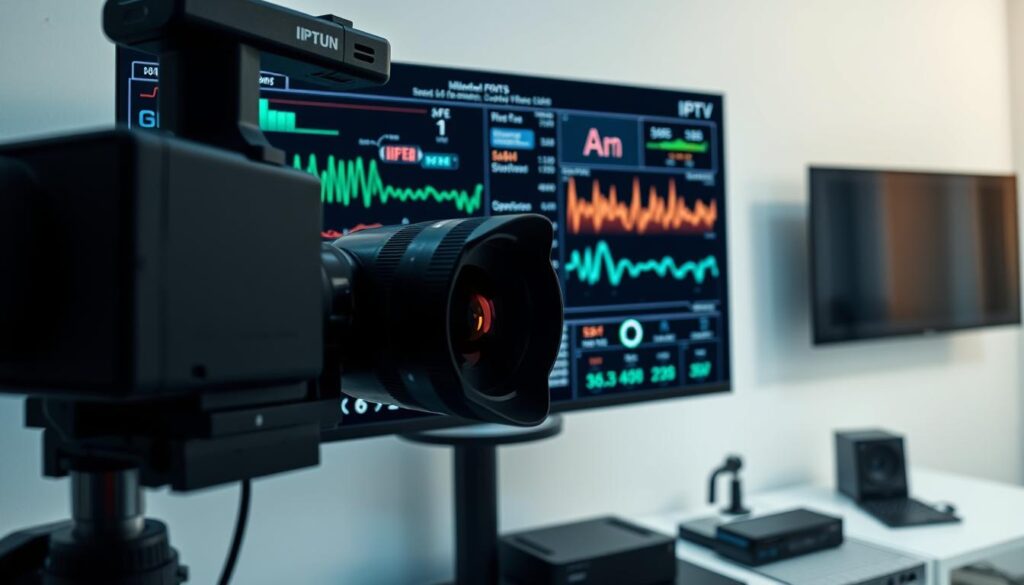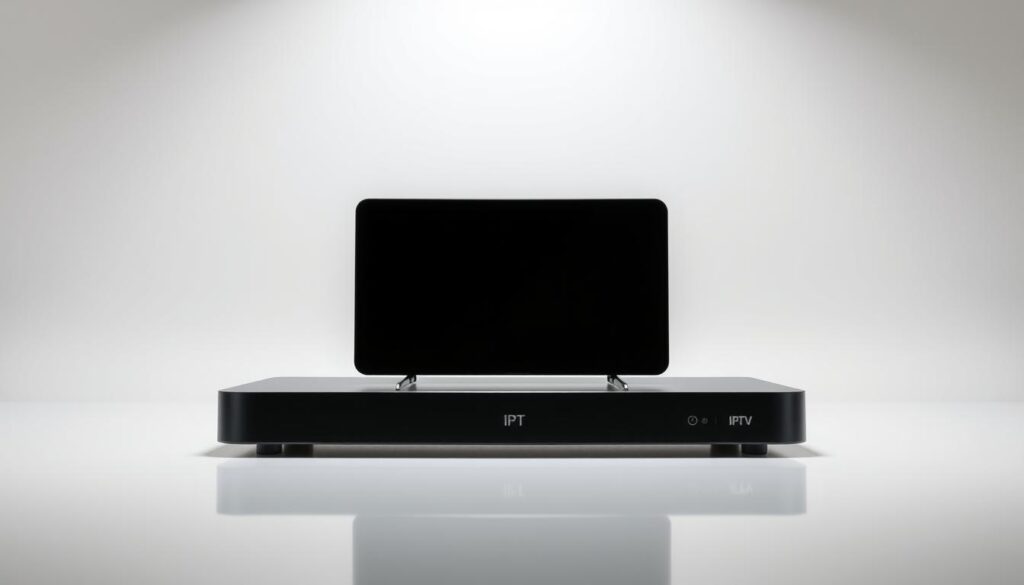I’m excited to share how I test IPTV for a great live TV experience. IPTV is popular for its wide range of content, like movies and sports. To stream without interruptions, it’s key to test your IPTV setup well.
My step-by-step method helps you find and fix any problems. This way, your viewing experience gets better. We check things like streaming quality and internet speed, which are important for a good IPTV test.
In this article, I’ll show you how to test IPTV for the best live TV experience. I’ll use my IPTV test to check TVShackTV.com, a well-known IPTV provider.
Introduction to IPTV Testing
An IPTV test is vital to make sure your streaming service works right. My IPTV test will help you get the most from your subscription.
Table of Contents
Understanding Why IPTV Testing Matters
Exploring IPTV, I’ve learned that testing is key for a great viewing experience. iptv test is vital for streaming quality. Issues like buffering, lag, and poor video resolution can be frustrating.
Testing early helps fix these problems quickly. Knowing what affects streaming quality, like internet speed and device capabilities, improves my IPTV experience. This is why IPTV performance is so important.
Regular iptv tests help solve these issues for a smooth viewing experience. The advantages of testing are clear, making it a must for keeping IPTV at its best.
Essential Equipment for My IPTV Test Process
To do a thorough IPTV test, I need the right tools. This includes a stable internet, a compatible device, and any needed cables or adapters. The quality of my gear is key to getting good test results, so I choose reliable and compatible devices.
When picking my IPTV test equipment, I look at a few things. I check if the devices are compatible, if the internet speed is good, and if the video quality is high. It’s important to test on different devices like smart TVs, set-top boxes, or streaming devices. This makes sure my IPTV setup works well for everyone.
Some of the main tools I use for my IPTV test are:
- A high-speed internet connection
- A compatible device, such as a smart TV or set-top box
- Necessary cables or adapters
- A stable power supply
Using the right IPTV test equipment helps me get accurate and reliable results. It also makes sure my IPTV setup is top-notch for users. Regular testing is key to keeping my IPTV setup running smoothly and providing the best experience.
Setting Up My Testing Environment
To get accurate and reliable results, setting up a proper iptv test environment is key. This means configuring my network for IPTV streaming, preparing my devices, and picking the right tools for analysis. A good testing environment helps spot and fix issues with my IPTV setup.
When setting up my testing environment, I focus on a few important things. These include:
- Network configuration needs, like a stable and fast internet connection
- Device preparation steps, like choosing the right devices and setting them up right
- Software tools, like those for network analysis and IPTV stream testing
By setting up my iptv test environment carefully, I make sure my tests are precise and dependable. This lets me find and fix any problems with my IPTV setup fast. This way, I can give my users the best IPTV experience.
In my experience, a well-set-up iptv test environment is vital for IPTV streaming quality and reliability. By following these steps and using the right tools, I can make sure my IPTV setup works well. This gives my users the best experience possible.
My Complete IPTV Test Methodology
I’ve created a detailed iptv test process to check all parts of IPTV performance. I look at video quality, audio sync, how fast channels switch, and if devices work well. This method helps me find and fix any problems with my IPTV setup.
My iptv test methodology uses the best practices and my own experience. I’ve learned that a detailed test is key for a smooth viewing experience. So, I follow a set of steps to check how well my IPTV works.
Some important parts of my iptv test process are:
- Evaluating video quality and resolution
- Assessing audio sync and quality
- Testing channel switching times and device compatibility
- Monitoring network performance and latency
By using these steps in my iptv test methodology, I make sure my IPTV setup works its best. This detailed approach helps me find and fix any issues, giving me a top-notch viewing experience.

Speed Testing for Optimal Performance
Speed is key for a smooth IPTV experience. I regularly check my iptv test speed to make sure everything runs well. This includes looking at my internet’s download and upload speeds, and latency.
Download Speed Requirements
For HD streaming, you need at least 25 Mbps. But for 4K, you’ll need even more. I use an IPTV speed test to check if my download speed is up to par.
Upload Speed Considerations
Upload speed matters too, like when using video on demand or interactive services. A quicker upload speed means faster requests, less buffering, and less lag.
Latency Assessment
Latency, or ping, is how long data takes to go from my device to the server and back. For live streaming and interactive services, low latency is a must. I use an iptv test speed tool to check my latency and keep it in check.
Video Quality Assessment Techniques
When I check my IPTV setup, looking at the IPTV video quality is key. I check things like resolution, frame rate, and compression artifacts. These can change how good the video looks. I use different ways to check the video quality, like asking viewers and using special software.
When I look at iptv test video quality, I focus on a few important things:
- Resolution: This is how many pixels are in the video image. More pixels mean sharper and clearer images.
- Frame rate: This is how many frames the video shows per second. More frames make the video look smoother.
- Compression artifacts: These are bad effects from video compression. They can make the video look blocky or blurry.
By using these methods, I can find ways to make my IPTV better. This way, I can make sure my users have the best IPTV video quality and a great watching experience.

Channel Switching and Loading Times
Channel switching and loading times are key in IPTV. As someone who tests IPTV services, I know how important they are. Fast switching and quick loading times make for a better viewing experience.
I focus on how quickly I can switch channels and how fast content loads. This helps me find and fix any issues in my setup. It also makes sure users have a great experience.
Several things can affect how fast channels switch and load. These include:
- Internet connection speed
- Device processing power
- Channel streaming quality
- Buffering and caching mechanisms
To improve my IPTV setup, I look at these factors. I use tools to measure response times and analyze buffer behavior. This helps me make my IPTV faster and more reliable.
Whether I’m testing one channel or many, my goal is to make the experience smooth. This way, users can enjoy watching without any frustration from slow performance.
Audio Sync and Quality Evaluation
Audio quality is as key as video quality in IPTV. I check for clarity, distortion, and video sync to ensure a great experience. I test different audio formats to find the best for my setup. This is a big part of my iptv test audio process.
To check audio quality, I use tools to analyze sound. I look for distortion, echo, or delay. I also make sure the audio matches the video perfectly. This helps me spot and fix any audio issues.
When I evaluate audio quality, I focus on a few things:
- Clarity: Is the audio clear and free of distortion?
- Sync: Is the audio in sync with the video?
- Format: Are the audio formats compatible with my setup?
By looking at these factors, I make sure my IPTV audio is top-notch. This is key to a great viewing experience. With the right audio settings, my IPTV subscription becomes more enjoyable.

Testing Different Video Resolutions
Video resolution is key in IPTV for a good viewing experience. I test SD, HD, and 4K resolutions to find any issues. This ensures the IPTV setup works well with all types of content.
Higher resolutions like 4K need more bandwidth and device power. Testing with different resolutions is vital for a smooth stream.
SD Content Performance
SD content is the simplest resolution. I check if the IPTV setup can handle it without problems. I look for buffering, lag, or pixelation.
HD Stream Analysis
HD streams need more bandwidth and power than SD. I check the HD stream for video quality issues like buffering or pixelation.
4K Content Capabilities
4K content is the highest resolution and needs the most power. I check if the IPTV setup can handle 4K without issues.
Testing various resolutions ensures the IPTV setup works well with all content. This process helps me find and fix any problems for the best viewing experience.
Multi-Device Compatibility Testing
To make sure IPTV works well on many devices, I test it thoroughly. I check how it performs on smart TVs, set-top boxes, phones, and tablets. This way, I can find any problems and make sure everyone can enjoy it, no matter what device they use.
I use different devices to test my IPTV. I look for smooth channel changes, great video, and clear sound. This helps me make sure my service works well for everyone, no matter their device.
Some important things I check include:
- Device compatibility: I make sure my IPTV works with lots of devices, like Android and iOS.
- Streaming quality: I check the video and sound quality on various devices to keep it top-notch.
- Channel switching: I test how fast and reliable channel changes are on different devices for a smooth watch.

Through detailed testing, I ensure my IPTV service is top-notch on any device. This makes users happy and sets my service apart. It’s a reliable and quality choice for streaming.
EPG (Electronic Program Guide) Functionality Check
I’m testing my IPTV setup, focusing on the Electronic Program Guide (EPG). The EPG is key for showing what’s on now and what’s coming up. I check it for any mistakes or outdated info. This is a big part of making sure the IPTV EPG works right.
I also look at how often the EPG updates. This is important because old info can confuse users. By checking these things, I make sure IPTV is easy and fun to use.
Some important things I check in the EPG are:
- Guide accuracy: I make sure it shows the right programs at the right times.
- Update frequency: I see how often it updates to keep info fresh.
- Usability: I check if it’s easy to use and if the info is clear.
Testing the EPG well helps make sure IPTV is top-notch. It meets user needs and expectations, which is key for a great IPTV experience.
Recording and Time-Shift Features
When it comes to IPTV services, recording and time-shift features are key. They give users control over their viewing. I test these features by checking if they can record and play back content well.
I look to see if the IPTV recording feature is easy to use. It should start and stop recordings on time and play them smoothly. I also check the time-shift feature, which lets users pause, rewind, and fast-forward live TV.
- Recording quality and stability
- Playback smoothness and responsiveness
- Ability to schedule recordings in advance
- Option to record multiple channels at once
Testing these features helps me ensure users have a great IPTV experience. They can watch their favorite shows whenever they want, thanks to iptv test recording and IPTV recording.
VPN Impact on IPTV Performance
Using a VPN with IPTV can change how well it works. It can affect how fast and clear your streams are. I test different VPNs to see how they change my IPTV experience.
I look at how different servers change performance. This helps me tell users how to get the best out of their IPTV with a VPN. The aim is to make sure streaming is smooth and uninterrupted.
- Speed tests to see how VPNs affect streaming speed
- How server locations impact performance, like latency and buffering
- If the IPTV VPN works well with different devices and platforms
Knowing these points helps users decide if a VPN is right for their IPTV. It’s about getting the best streaming quality, security, or access. Testing VPNs thoroughly is key to getting the most out of them.
Analyzing Long-Term Stability
To make sure IPTV works well, it’s key to check its stability over time. I watch my IPTV setup closely to spot any ongoing problems. I look at error rates, stream quality, and how often it’s up and running.
By focusing on IPTV stability, I build trust with my users. This helps keep them from leaving because of service issues. Regular iptv test stability checks let me catch problems early.
When I check long-term stability, I think about a few things:
- Error rates and how often they happen
- How steady the stream quality is
- How often the system is up and running
By making IPTV stability a priority and doing iptv test stability often, I keep my service top-notch. This makes my users happy and keeps them coming back.
Conclusion: Maximizing Your IPTV Experience Through Testing
Testing your IPTV setup is key to a great live TV experience. I’ve learned to check streaming quality, device compatibility, and stability. This helps me fix any issues and give viewers a smooth service.
Testing often is vital in the fast-changing IPTV world. Keeping up with new tech and user needs is important. It helps me stay ahead and keep customers happy. By focusing on testing and using data to improve, I ensure a top-notch IPTV experience for everyone.
If you’re into IPTV, don’t overlook the importance of testing. It helps improve performance, reliability, and user interaction. Use the insights from testing to enhance your IPTV service and reach its full capability.
FAQ
What is the importance of IPTV testing?
IPTV testing is key to a great TV experience. It finds and fixes streaming quality, device, and internet speed issues. This makes watching TV better for everyone.
What equipment do I need for IPTV testing?
You’ll need a stable internet, devices like smart TVs or streaming devices, and cables or adapters.
How do I set up my IPTV testing environment?
First, set up your network and devices. Then, pick the right tools for analysis. This makes sure your tests are accurate and reliable.
What does your IPTV test methodology involve?
My method checks video quality, audio sync, and channel switching times. It also looks at device compatibility. This helps find and fix any problems with your IPTV setup.
How do you assess internet speed for optimal IPTV performance?
I test download, upload speeds, and latency. A 25 Mbps download speed is needed for HD streaming.
How do you evaluate video quality for IPTV?
I use viewer feedback and special software to check video quality. This ensures your IPTV delivers top-notch video.
How do you test channel switching and loading times?
I measure how fast channels switch and analyze buffer behavior. Quick channel switching and loading times are essential for a smooth viewing experience.
How do you evaluate audio sync and quality?
I test audio clarity, distortion, and sync with video. This ensures your IPTV setup offers high-quality, synchronized audio for a better viewing experience.
How do you test different video resolutions?
I check how SD, HD, and 4K content performs. This ensures your IPTV setup can handle various content types and meet user preferences and device capabilities.
How do you test multi-device compatibility?
I test your IPTV service on different devices. This includes smart TVs, set-top boxes, smartphones, and tablets. It ensures compatibility across platforms and enhances user convenience.
How do you test the Electronic Program Guide (EPG) functionality?
I check the EPG’s accuracy and update frequency. This ensures users can easily find and watch their favorite programs, improving their experience.
How do you test recording and time-shift features?
I evaluate recording and time-shift features. This includes scheduling recordings, playback quality, and fast-forward or rewind. It gives users more control over their viewing experience.
How do you test the impact of VPN on IPTV performance?
I compare speeds with and without a VPN. I also check how different server locations affect IPTV performance. This helps optimize the IPTV experience when using a VPN.
How do you analyze long-term stability of the IPTV setup?
I monitor the IPTV setup over time. I track error rates, stream quality, and system uptime. This ensures a reliable and trustworthy IPTV service in the long run.
